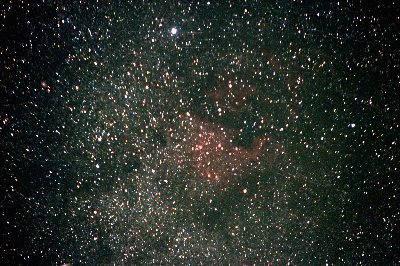

This article is based on a talk I gave to the Bridgwater Astronomical Society in January 2005.
Astronomy covers a huge field of interests. It's not just about going out on a dark night and looking at the sky, but that is where just about everyone starts, even if they then move on to something which doesn't involve them putting their eye to a telescope, so we're going to look at observational astronomy.
We're going to look at what there is out there to see, what it is and how it got there.
We're going to look at where to find it.
We're going to look at how to look at it.
Let's start at the beginning. It's a dark, clear night, you go outside and you look up. What do you see? Stars. Thousands upon thousands of stars. But how did they get there? Well, we don't know the whole story, but we can theorise.
What you have to remember is that there's a lot about what's going on Out There that we don't know, and a lot of what we think we know is theoretical. Even the Big Bang is still just a theory. The Hubble Space Telescope wasn't built so that you and I could look at pretty pictures of the Eagle Nebula. It was built to look back in time. The aim, to discover once and for all the origins of the Universe. But Hubble isn;t big enough. Hence the need for very large telescopes or telescope arrays - using multiple smaller telescopes as one large one. The OWL - overwhelmingly large telescope - is already in the planning stage. What's next? UFL? Unfeasably large telescope? Whatever it is, most of these telescopes work in the non visible parts of the spectrum, which is why things like comets are often discovered by amateurs, going out on a dark night and looking up.
However to return to the origin of stars, rather than the universe, bear in mind that a lot of this is theory and is subject to change.
We'll start with what we call deep sky objects.
In the beginning the universe was nothing more than a soup of hydrogen. It wasn't a perfectly uniform soup - it couldn't have been. If it had been it probably still would be today. But it wasn't, and any tiny particle, even a hydrogen atom, will attract another particle, and now the two particles together can attract another particle from slightly further away, and so in the denser bits of the soup particles start to clump together, and the denser bits get denser. Finally we end up with a whole cloud of denser hydrogen, and that cloud is an embrionic galaxy.
No stars yet, so a galaxy, yes, but not as we know it, but the attraction between particles continues and we get even denser bits in our galaxy, and we'll call these nebulae, which means clouds. Now we're starting to get really dense, although if you were out there in space you wouldn't exactly be fighting your way through, and the hydrogne starts to react and get hot, and attract more hydrogen and get hotter. When hydrogen reacts like this it starts to form helium, and you probably realise that now we're talking about stars.
 This
is a star forming nebula within our oun galaxy. It's known as the Lagoon Nebula,
M8 or NGC6523, and in here there's more than a single star forming. There's
a whole group, or cluster, of stars.
This
is a star forming nebula within our oun galaxy. It's known as the Lagoon Nebula,
M8 or NGC6523, and in here there's more than a single star forming. There's
a whole group, or cluster, of stars.
When the process is complete most if not all
of this gas cloud will have been absorbed into the stars. What we'll see then
is something like this. 
If you think this star cluster looks something like the Pleiades, well it is the Pleiades. It's a genuine star cluster, born and raised together, and if you look at the Pleiades with a pair of binoculars and think it looks faintly hazy, well you're right again. Some of the nebulosity, or the gas cloud the stars were formed from, is still there, as you can see in this image. Open clusters like the Pleiades can contain anything up to a hundred or more stars, but there are clusters containing hundreds of thousands of stars.